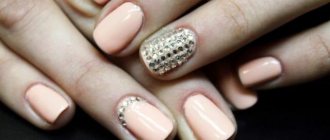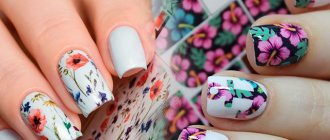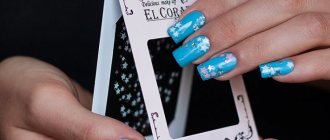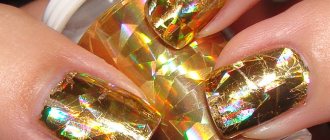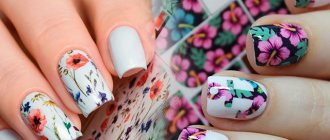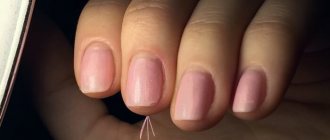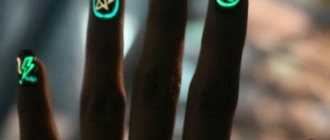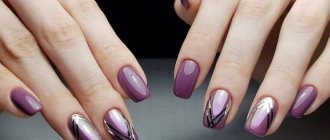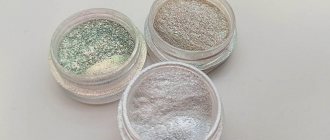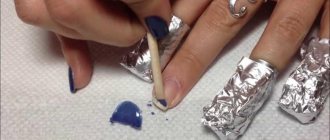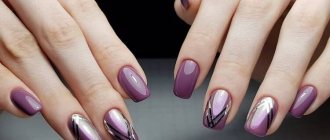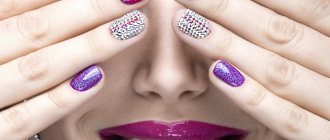Types and features of using nail foil
Manicure with foil has many ideas and variations. It is used for everyday and evening design. You can apply foil to your nails as a base coat or as an accent decoration. Shiny material is used to create abstract designs, three-dimensional patterns, and delicate compositions.
Tear-off
Available in rolls or stickers. Tear-off foil is used for nail extensions or finishing nail designs. Before decorating, you need to cut or tear off the required number of fragments along the perforated lines.
How to apply nail foil:
- Perform a classic manicure and correct the shape.
- Polish your nails so they are not rough.
- For a stronger hold, apply primer.
- Cover your nails with base coat and dry in UV rays.
- Apply two layers of colored gel polish, drying alternately.
- Cut out shapes, fragments for a pattern, try them on your nails.
- Apply special glue to the back side of the material.
- Lay out the drawing with tweezers, straightening the fragments with a pusher or stick.
- Fix with topcoat after a few hours, dry, remove the sticky coating.
It takes patience to apply the foil correctly. If there are any shortcomings in the work, they can be corrected with a nail file.
It is allowed to replace the gel with a classic colored varnish, and the finishing top with a transparent layer.
Transferable
Suitable for beginners because transfer foil is easier to use. The material is produced in rolls, packaged in plastic containers. This ensures a long shelf life. The structure of the product is less dense and costs less than tear-off samples.
How to glue transfer foil:
- prepare your nails in the usual way;
- apply colored varnish or shellac of a suitable color;
- air dry or process under a lamp;
- Apply glue on top and let it dry completely;
- cut off a fragment and apply it to the center of the nail plate;
- press lightly, smooth with a wooden stick;
- pry off the protective film and remove;
- fix the result with a top coat after a couple of hours.
If the desired effect is not achieved immediately, the procedure can be repeated. It is necessary to use the glue again, dry and transfer the foil. When a manicure is performed for one evening, it is not necessary to fix the decor with a top coat.
Little secrets and interesting nuances
Today, manicures done using special nail foil are very popular. But, according to experts in this matter, there is no way to do this without high-quality glue. After all, even the most beautiful and elaborate foil will not be able to be fixed by the most experienced craftsman if he uses poor glue for this.
As consumer reviews indicate, it is better to buy such a product only in stores with a good reputation, specialized salons, and not throw money down the drain on a low-quality, cheap product purchased on the market. In addition, the price of glue for foil is more than affordable for every fashionista. In order to understand how to use this glue correctly, just watch the videos presented.
It is worth clarifying that there are two types of foil for manicure – transferable and non-transferable.
- You can cover the entire nail plate with transfer foil, but small details and patterns will be more difficult to create.
The non-transferable one is not so practical for use over the entire plate, since you have to cut it exactly according to the shape of the nail. But it is ideal for decorative elements; you just have to cut them out first and apply them to the glue-coated nail plate.
Which foil glue to choose and how to use
To make a brilliant Hollywood manicure, you need to choose a decorative material and glue for it. Special compositions have a strong hold, so they firmly hold the foil on the nails.
Global Fashion
Hypoallergenic gel adhesive for transfer-type foil. Global Fashion dries quickly and sets well. The glue is sold in 15 g tubes with a narrow or wide brush. Place foil on the dried product, press down, and then tear it off with a sharp movement. The design is imprinted onto the glue on the nail plates. Use topcoat to secure.
Rio Profi
The transparent product leaves a glossy finish on the surface. The special features of Pro glue for transfer foil are fast drying time, uniform distribution, and water-repellent properties. Complete polymerization of the composition occurs within 3 minutes. How to glue foil with glue: apply, wait a couple of minutes, attach the transfer fragment, align, sharply tear off from the plate, fix with topcoat.
Jina
Jina glue dries quickly and evenly and secures complex decorative elements well. You can dry the material without using a lamp. The product is sold in a compact jar with a brush and is inexpensive. Foil glue is used after applying colored varnish or shellac.
Kodi Professional
The standard volume of a glue bottle is 10 ml. The composition is hypoallergenic, after drying it forms a transparent coating on the nails. The design can be transferred to the entire nail or part of it. Before gluing, you need to wait 3 minutes for the product to exhibit adhesive properties.
Naomi Foil Glue
Manicure glue is convenient to use for casting techniques. Sufficient stickiness ensures reliable fixation of tear-off and transfer foil. You can treat your nails completely or partially. Naomi Foil Glue is sold in a 12 ml tube with a nylon brush.
Hongyi
The glue holds decorative decorations well, including rhinestones and applied tips. Suitable for mirror manicure with a transfer pattern. The product is released in a 16 ml tube with a thin brush. After application to the nails, the layer is dried without a UV lamp, the material is applied, the excess fragments are trimmed after 5 minutes, and the nails are covered with transparent varnish.
Star Gel Glue E.Co Nails
E.Co Nails adhesive gel with a sticky layer is available in a compact 10 ml bottle with a built-in brush. First, apply a gel polish base and dry it under a lamp. Then cover the nails with glue and polymerize for 60 seconds under LED lighting. The foil is torn off, the ends of the plates are sanded with a soft buffer, and a top coat is applied.
Jess Nail
Jess Nail transfer foil adhesive is also suitable for gluing tips, rhinestones, sparkles, and can be used to restore nail plates. To obtain the desired effect, it is recommended to use a base that matches the foil under the gel polish. Before applying the glue, you need to remove the sticky layer, let the composition dry for a minute, and print the design.
Art Star Glue
With glue from the manufacturer KaSi, you can create nail designs from transfer foil. Art Star Glue is sold in 16 ml bottles with a built-in brush. The design is transferred to the nails after applying the glue and the substance becomes transparent.
When decorating nails with foil, you need glue, gel polish or regular polish, a base and top coat, an orange stick or a pusher. The excess part of the material is cut off with nail scissors, filed down, and the edge of each plate is sealed.
Before applying the foil, you need to let the glue dry for 1-3 minutes. When the product becomes transparent, you can glue the decor.
Review of the best manufacturers
The popularity of extended nails is not decreasing, since thanks to modern materials they can be chosen for any look. Consumables are constantly being improved and their quality is improving. Competition between manufacturing companies contributes to the fact that the consumer becomes confident in the environmental friendliness, naturalness, health benefits, high strength and reliability of nail glue.
Coo-Coo-City
The nail glue package contains two components contained in plastic containers. Their contents are mixed in equal volumes, having first broken off both tips. The glue ensures good adhesion of the tips and securely attaches rhinestones, silk and other decorations. The glue does not cause harm, is non-toxic, and is strong and reliable. The volume of the product is 25 milliliters.
ORLY
The manicure set for nail repair includes:
- bottle with glue and brush - polymethylacrylate, 5 g;
- powder - quartz, acrylic polymer, 4.25 g;
- sanding block measuring 3.5 cm x 3.5 cm x 0.3 cm.
Glue can be used to easily repair a cracked or damaged nail. To do this, you need to apply glue to the plate and then immerse it in powder. The coating is polished with a sanding block after the glue has dried. To ensure a stronger adhesion, it is necessary to apply a second layer of glue and powder.
Nail Glue
According to experts, Nail Glue is one of the best glues. It comes in a 3 ml bottle and is designed for quickly gluing artificial nails and repairing natural ones. Before using glue, it is necessary to remove fat, oil, and varnish from their surface. After this, a drop of the product is applied to the damaged area. If necessary, for better adhesion, press the gluing area with a wooden stick. After use, the spout of the container is wiped and closed with a cap.
KODI Professional
Using KODI Professional glue you can easily glue tips onto a natural nail and then give it the desired shape and length. The consistency of the product is viscous, the appearance is transparent. The bottle of glue is equipped with a brush, small and convenient. With its help, it is easy to apply glue to the nail plate without staining the skin. The product dries instantly. It has no toxic or irritating effect, is easy to use, and therefore can be used at home.
Kiss Brush On Nail Glue
Kiss Brush On Nail Glue is designed for fixing tips. It is convenient to apply, for which you need to distribute a small amount of the product over the inside of the false nail and rub it with the spout of the bottle. After this, place it on a natural one and press for a few seconds. It is necessary to avoid the appearance of air bubbles so that peeling does not occur prematurely. Excess glue is carefully removed. To remove the glued plates, use a special liquid.
RuNail
RuNaiL brand glue meets all medical standards and contains no toxic substances. The consistency of the liquid is viscous and transparent. There is no smell. Reliably glues tips to the surface of the natural nail. Adhesion, fixation and hardening occurs in just 6-8 seconds.
How can I replace foil glue on my nails?
Instead of a special product for decorating nails, you cannot use super glue, PVA, Moment glue, or other aggressive compounds. They are unsafe for nail plates and destroy their natural shine.
Gel polish
To make a manicure without glue using durable gel structures, you will need a UV lamp or LED source, a standard set of tools (scissors, pusher, buff), nail foil of any kind, and means for applying shellac (base, top, colored gel).
How to properly glue foil onto gel polish:
- perform normal preparations;
- apply a thin base coat;
- dry under the lamp according to the instructions;
- use a primer for fixing;
- prepare fragments for the pattern;
- if the material is untranslatable, cut out the elements;
- Do not remove the sticky layer of the gel; place foil on it with tweezers;
- Use a stick to smooth out the shiny figures;
- if the material is transfer, tear off the film with a sharp movement so that the design is printed, repeat the procedure if necessary;
- if the foil is tear-off and sticks to the entire nail, cut off the excess part with scissors;
- apply the top: it must be dried (if using LED light, dry for 60 seconds, if using a UV lamp, hold for 2-3 minutes);
- remove the dispersive sticky layer.
In the same way, you can glue crumpled foil and transfer material onto shellac gel polish.
Stickers
Film coatings have become an alternative to the usual nail polish. Ease of application and a wide choice of designs, patterns, and textures make home manicure popular.
The main rules and order of how to use nail stickers are as follows:
- Prepare the nail. To do this, you will need to remove the cuticle and polish the surface with a buff for reliable adhesion to the film coating, and then degrease.
- Remove the protective sheet from the sticker and apply the adhesive side to the nail.
- Gently and thoroughly smooth the coating with a wooden or plastic spatula to remove any air residue.
- The edges, if necessary, are trimmed and processed with a ceramic or glass file.
Methods for gluing stickers on gel polish differ in the additional use of a top coat.
Types of stickers
Varieties of stickers are distinguished according to the following parameters:
- the size of the nail covering;
- design features;
- methods of application.
There are 2 types of stickers based on size: those covering the nail plate completely and partially.
Among the options with full coverage, or stickers on the entire nail, there are:
- Applique (transparent, one-color, with a sparse pattern);
- Manicure (with an image covering the entire space).
A one-color film, or “dry varnish,” allows you to do without the usual salon procedures and the need to patiently dry your nails. The choice of film prints is huge: in color, style, texture. Creating a three-dimensional surface is a separate direction - 3D stickers on nails, otherwise such a coating is called beaded.
Three-dimensional stickers are elements with a convex shape. This model is used for especially special occasions. In everyday life, three-dimensional design is less practical than flat options.
Photo mini-images occupy a special place among the varieties of stickers. Designer searches for color collages from photographs and pictures are always unique and original.
Sets of self-adhesive tapes of different widths and colors have gained popularity. The thinnest versions of strips for creating decor on different bases are more convenient to work with: varnish, gel or acrylic. Decisions on how to glue tape on nails will be determined by the shape of the plate, style matching the image and imagination.
Special ornaments have been developed for extended nails. They are large in size and are designed for combination or holistic nail design options.
Gluing method
Stickers are thin and fragile, so careful handling of the material is required. The picture should be placed strictly in the center and the image should be fixed.
Manicure with stickers is applied in different ways. Among the first were water stickers on nails, similar to children's decals, and then fashionistas learned how to glue stickers on nails from Aliexpress.
Before pressing it to the nail, you need to hold the image in warm water. After carefully removing the paper part, the film with the pattern remains in place. After drying, you need to coat the nail with a fixative varnish. It is almost impossible to distinguish transfer stickers on nails from the salon work of a master.
The second method is universal. Even teenage girls know how to properly apply stickers on nails if the surface is sticky. You need to carefully apply the desired side of the film onto the base dried base varnish, and the process is completed. Additionally, it is recommended to coat the nails with a finishing varnish to strengthen the result and prevent rapid abrasion of the decorative layer.
If a mistake is made and a distortion of the pattern is observed, then the flaws can be corrected using
- beads, rhinestones, acrylic paint or shiny varnish;
- replacing the picture with a new one.
Experience in use will tell you how to peel off the sticker and re-design the nail. The decorative technique is clear and accessible.
Manicure ideas with foil
The entire palette of shades is used for design - any version of shiny decor is in trend. Bright colors, matte shades, and mirror finishes are popular. How to make a manicure with foil:
- Versatile silver material suitable for everyday design. Combines with pastel gel polishes in pink, powdery, blue, milky shades.
- Gold foil looks interesting in formal looks and evening manicure. Looks impressive on a black background, combined with green, blue, red, white. You can glue the decor with stripes or patterns.
- Colored metallic coating looks beautiful with a contrasting background, combined with nude shades and rich monochromatic varnishes. You should not use acid tones - they are not in fashion.
- Matte manicure in nail design gives the image nobility and sophistication. Compositions of shiny pieces, ornaments of thin stripes, and three-dimensional designs with a casting effect look interesting against a velvety background.
- Lunar manicure is a current classic. You can decorate the hole with shiny material, giving it any shape. It is better to use contrasting combinations of foil and colored varnish.
- A French jacket with a shiny free edge or an emphasis on the “smile line” is suitable for everyday and formal design. Oblique and straight French looks beautiful. You can take sheet and transfer material for work.
- The design with multi-colored dots is made from crumpled foil. It needs to be finely torn and randomly placed on glue or sticky varnish.
- A reflective mirror manicure is easiest to do using thermal film. After heating, the product becomes soft and lies evenly on the entire surface of the nail plate.
A win-win option is to decorate your nails with shiny stripes. They can be hung in different directions, narrow and wide fragments can be used, and geometric patterns can be made.
Requirements for the adhesive composition
The general requirements for the adhesive composition are as follows:
- hypoallergenic;
- provides strong fixation to the nail plate;
- creates a reliable connection;
- upon contact with water retains its original properties.
The characteristics of the adhesive depend on the type of foil with which the composition is used. These parameters determine the service life of the connection between the nail plate and the applied material.
The following types of foil are produced for nail treatment:
- Tear-off. Available in the form of stickers or in rolls. This foil material is used for nail extensions or finishing plates.
- Translated. Used mainly by novice manicurists. This product is less expensive than tear-off foil, but is also available in rolls.
- Thermo foil. Such stickers are fixed on the nail plate without glue. In this case, gel polish is used for fastening.
- Foil for casting. This sticker option allows you to create an original design. Thanks to this foil you can create a casting effect. This material is often combined with matte stickers.
- Reaped. Thin material, produced in compact containers, is used to create aquarium manicure.
- Holographic. Available in various forms, including self-adhesive stickers.
- Stencil. This type of foil is recommended to be fixed on nails using an adhesive composition.
There are other options for manicure foil. Some types of stickers, as noted above, do not require the use of glue. If thin material is applied to the nails, it is recommended to purchase compounds that do not deform the foil.
Expert advice
It is not always possible to glue foil onto your nails the first time. If you do not follow the technology, the decor will bulge and look sloppy. Recommendations from nail technicians for creating a brilliant design:
- Nails must be perfectly prepared and covered with a base coat.
- Foil must always be applied to a sticky surface, otherwise the material will not stick (except for stickers).
- If the decor is made without glue, there is no need to dry the gel polish or regular polish under a lamp.
- In order to print foil on shellac with high quality, the dispersion layer cannot be removed from it.
- If glue is used for fastening, the product should become transparent, and then foil can be glued to it.
- The thermal material must be heated with a lamp or hairdryer before gluing.
- If the transfer foil is not printed the first time, you need to repeat the procedure, pressing the decor harder.
In order for the manicure to last longer, you need to secure the work with a top layer and seal the free edge of the nail plates well.
A manicure with foil is called Hollywood for its spectacular shine, expressiveness, and brightness. Decorating your nails with shiny fragments adds an original touch to your design. Foil can be glued in any combination, so each work will be unique.
How can you color your hair with it?
The algorithm for using foil in the salon and at home is the same:
- prepare foil and other accessories and consumables necessary for painting (paint, bowl, brush, etc., according to the instructions);
- cover your shoulders, put on gloves and prepare the blonding composition;
- Divide the hair into several zones, holding them together with clips;
- separate a thin strand from each zone with a comb;
- Place a strip of foil under the strand and apply lightener with a brush from the top edge of this strip to the very ends of the hair;
- wrap the strip;
- Treat the entire head in the same way.
Methods for wrapping foil:
- envelope - considered the classic method, used on any strands except very thin and short ones (that is, 1 cm or less);
- the “overlapping” or “overlap” method - very similar to the “envelope” method, ideal for coloring from the roots when darning;
- semicircle - used to apply lightener to strands selected with oval partings (resembling a horseshoe);
- trapezoid - used on small, narrow strands.
These are just the basic methods; in the practice of hairdressers there are many more of them. Moreover, every craftsman (and even a non-professional) can invent his own convenient way of wrapping this plastic aluminum material.
Reuse
Foil does not react with the coloring composition, and therefore good quality aluminum hairdressing paper can be reused many times. The only requirement is that it must be thoroughly washed and dried before reuse.
Types of popular decor in nail art
Nail designs with foil are in demand among many girls. But not all fashionistas know that there are several varieties of this decor. And depending on the type of coating, the technique of performing nail design changes. So, this film comes in the following types:
- Transfer film is the most commonly used type of film. To transfer it you will need special glue. By the way, instead of glue, you can use gel polish. But the used PVA glue in this case will not help to glue the decor.
- Sheet - unlike the first type, this material is thicker; it is not reprinted onto the nail, but remains completely on it, leaving no protective backing.
- Thermofoil - its peculiarity is that it is applied after pre-heating. It does not require glue, since the sticker itself is already equipped with an adhesive composition.
- Tear-off is a very soft material; for design, it is torn into small pieces using tweezers. This film is applied to wet varnish or topcoat.
Instructions for use
The use of Loctite products may vary depending on the composition and purpose of the substance.
Loctite 243
This is a one-part sealant that is used to seal threaded elements. It is characterized by high resistance to vibration or unscrewing. The substance is produced in the form of a spray equipped with a nebulizer.
401
This universal product can be used for paper or cardboard. It is also suitable for vulcanized rubber, suede, and leather. With the help of such glue it is possible to fasten textile elements. The substance is released in the form of a one-component liquid.
Before using the substance, it is recommended to degrease and dry the surfaces. Wooden elements should be cleaned and coated with primer. It is recommended to apply glue to both surfaces. This should be done in a thin layer of 2-3 millimeters. Then the elements should be connected and left for 24 hours at a temperature of +20-23 degrees.
406
This is a cyanoacrylate adhesive that is characterized by rapid polymerization. It is used when it is necessary to quickly fix elements made of plastic, rubber, or metal. The composition is also used for bonding alloys or polymers. It is recommended to apply the product to a cleaned and degreased surface. The thickness of the layer should not exceed 2-4 millimeters. Excess glue does not affect the quality of the adhesion, but increases the drying period.
Maximum strength can be achieved after a day.
Shaft-sleeve clamp Loctite 638
This seal is used for cylindrical elements. It also helps secure the bearings. It is recommended to apply the substance to cleaned and dried elements.
496
This product is intended for metal. It has a long setting period - it takes 10-30 seconds.
3421
This is a two-component epoxy adhesive that has a low curing rate at room temperature.
